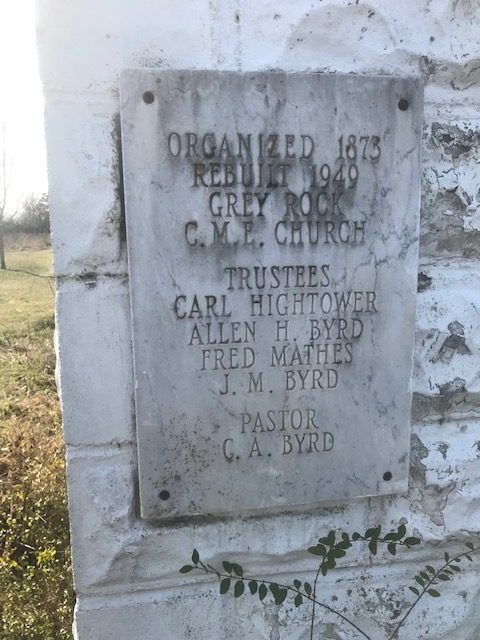By Dr. Curtis Varnell
The old church stands dilapidated, paint peeling and deserted on the outskirts of the tiny Afro-American town of Grey Rock. A testament to its history, the cornerstone reads, “founded 1873, rebuilt 1949, C.M.E.” Nearby stands a memorial to its founders, former slaves Allen and Sarah Byrd. The site has become the central focus of the community and its foundation.

Allen was born into slavery on the Titsworth’s plantation near Roseville in 1815. Allen’s mother, a slave of the Titsworth family, was brought into Arkansas when the Titsworth family moved to the area from Kentucky. He grew up on the plantation where he worked the cotton fields in nearby McLean bottoms or assisted at the port owned by the Titsworth family. Alfred eventually married a fellow-slave Sarah and they parent 16 children, all but one born in Arkansas and all born into slavery.
Titsworth, a southern sympathizer, evacuated to Texas during the Civil War and took several slaves including the Byrd family to Texas with him. Alfred was the first to become a freeman, possibly given his freedom in 1862 when John Titsworth passed away. Oral history states that Alfred continued to work for the family until he could purchase his wife. When the war ended, the entire group returned to the war-torn and devastated river valley. Each of the former Titsworth slaves were provided 40 acres of land and Grey Rock developed as a community center servicing the former slaves. Byrd, obviously an industrious man, began to buy up adjoining land and became prosperous enough to deed a minimum of 40 acres to each of his children.


Byrd and his descendants were instrumental in the development of the community. One of the first orders of business was to create a place of worship. Like many former slaves, they desired to create religious institutions separate from their former slave masters. Allen and his wife donated one acre of land for the formation of a Methodist Church, soon to become a part of the African Methodist Episcopal Church: AME. The AME, a church originally formed by freemen in the North, rapidly grew to become one of the largest churches of former slaves. As soon as the Civil War was over in Arkansas, the Reverend Nathan Warren established the AME church in Helena and in Little Rock. The church included service, education, and the social and political uplift of African-Americans as a part of their ministry. Shorter College, founded in 1886, was a part of this movement.

The original Grey Rock church was torn down and replaced by a new structure in 1949. Generations of the Byrd family were members of the Grey Rock AME, serving as Trustees, Sunday school teachers, and even as ministers at the church. The church has served as community center, meeting place, and a place for family meetings for well over one-hundred years. In 1918, the family placed a stone on the church grounds memorializing the Byrd family contributions to the area. The grounds are now a part of the Arkansas Register for Historic sites. The largest road to the nearby county seat at Paris is still named Byrd Road as a testament to this family.
Windows are cracked and broken, the door ajar. Inside, worn out pews and scattered hymnals exist beside junk and debris left by vagrants. A shadow of what it once was, the building is slowly fading into oblivion. Closing my eyes, my imagination reaches to the past and I can almost see the congregation as they enthusiastically worship to the soft appeal of the old Gospel songs of the past.






